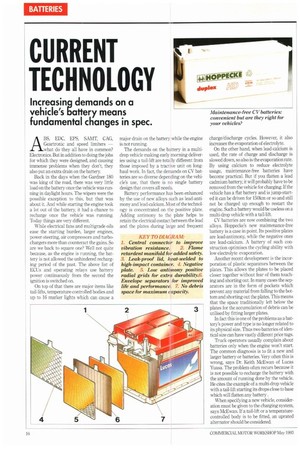CURRENT TECHNOLOGY
Page 120

If you've noticed an error in this article please click here to report it so we can fix it.
ABS, EDC, EPS, SAMT, CAG, Geartronic and speed limiters — what do they all have in common? Electronics. But in addition to doing the jobs for which they were designed, and causing immense problems when they don't, they also put an extra drain on the battery.
Back in the days when the Gardner 180 was king of the road, there was very little load on the battery once the vehicle was running in daylight hours. The wipers were the possible exception to this, but that was about it. And while starting the engine took a lot out of the battery, it had a chance to recharge once the vehicle was running. Today things are very different.
While electrical fans and multigrade oils ease the starting burden, larger engines, power-steering, air compressors and turbochargers more than counteract the gains. So are we back to square one? Well not quite because, as the engine is running, the battery is not allowed the unhindered recharging period of the past. The above list of ECUs and operating relays use battery power continuously from the second the ignition is switched on.
On top of that there are major items like tail-lifts, temperature-controlled bodies and up to 16 marker lights which can cause a major drain on the battery while the engine is not running.
The demands on the battery in a multidrop vehicle making early morning deliveries using a tail-lift are totally different from those imposed by a tractive unit on longhaul work. In fact, the demands on CV batteries are so diverse depending on the vehicle's use, that there is no single battery design that covers all needs.
Battery performance has been enhanced by the use of new alloys such as lead-antimony and lead-calcium. Most of the technology is concentrated on the positive plate. Adding antimony to the plate helps to retain the electrical contact between the lead and the plates during large and frequent charge/discharge cycles. However, it also increases the evaporation of electrolyte.
On the other hand, when lead-calcium is used, the rate of charge and discharge is slowed down, so also is the evaporation rate. By using calcium to reduce electrolyte usage, maintenance-free batteries have become practical. But if you flatten a lead cadmium battery, it will probably have to be removed from the vehicle for charging. If the vehicle has a flat battery and is jump-started it can be driven for 150km or so and still not be charged up enough to restart the engine. Such a battery would be useless on a multi-drop vehicle with a tail-lift.
CV batteries are now combining the two alloys. Hoppecke's new maintenance-free battery is a case in point. Its positive plates are lead-antimony, while the negative ones are lead-calcium. A battery of such construction optimises the cycling ability with low electrolyte evaporation.
Another recent development is the incorporation of plastic separators between the plates. This allows the plates to be placed closer together without fear of them touching and shorting out. In many cases the separators are in the form of pockets which prevent any material from falling to the bottom and shorting out the plates This means that the space traditionally left below the plates for the accumulation of debris can be utilised by fitting larger plates.
In fact this is one of the problems as a battery's power and type is no longer related to its physical size. Thus two batteries of identical size can have vastly different price tags.
Truck operators usually complain about batteries only when the engine won't start. The common diagnosis is to fit a new and larger battery or batteries. Very often this is wrong, says Dr. Keith McEwan of Lucas Yuasa. The problem often recurs because it is not possible to recharge the battery with the amount of running done by the vehicle. He cites the example of a multi-drop vehicle with a tail-lift starting its drops close to base which will flatten any battery .
When specifying a new vehicle, consideration must be given to the charging system, says McEwan. If a tail-lift or a temperaturecontrolled body is to be fitted, an uprated alternator should be considered.
































































































































